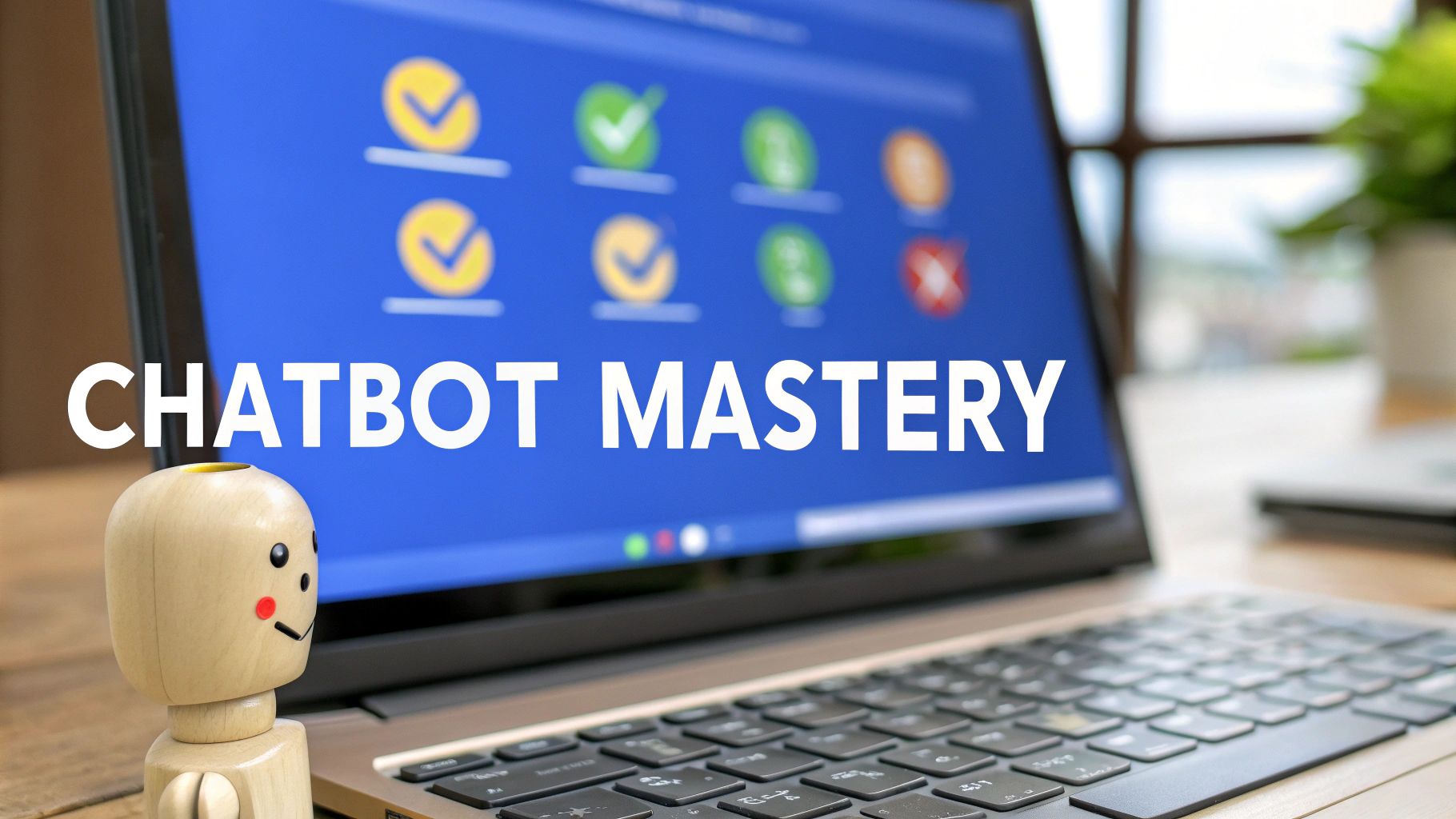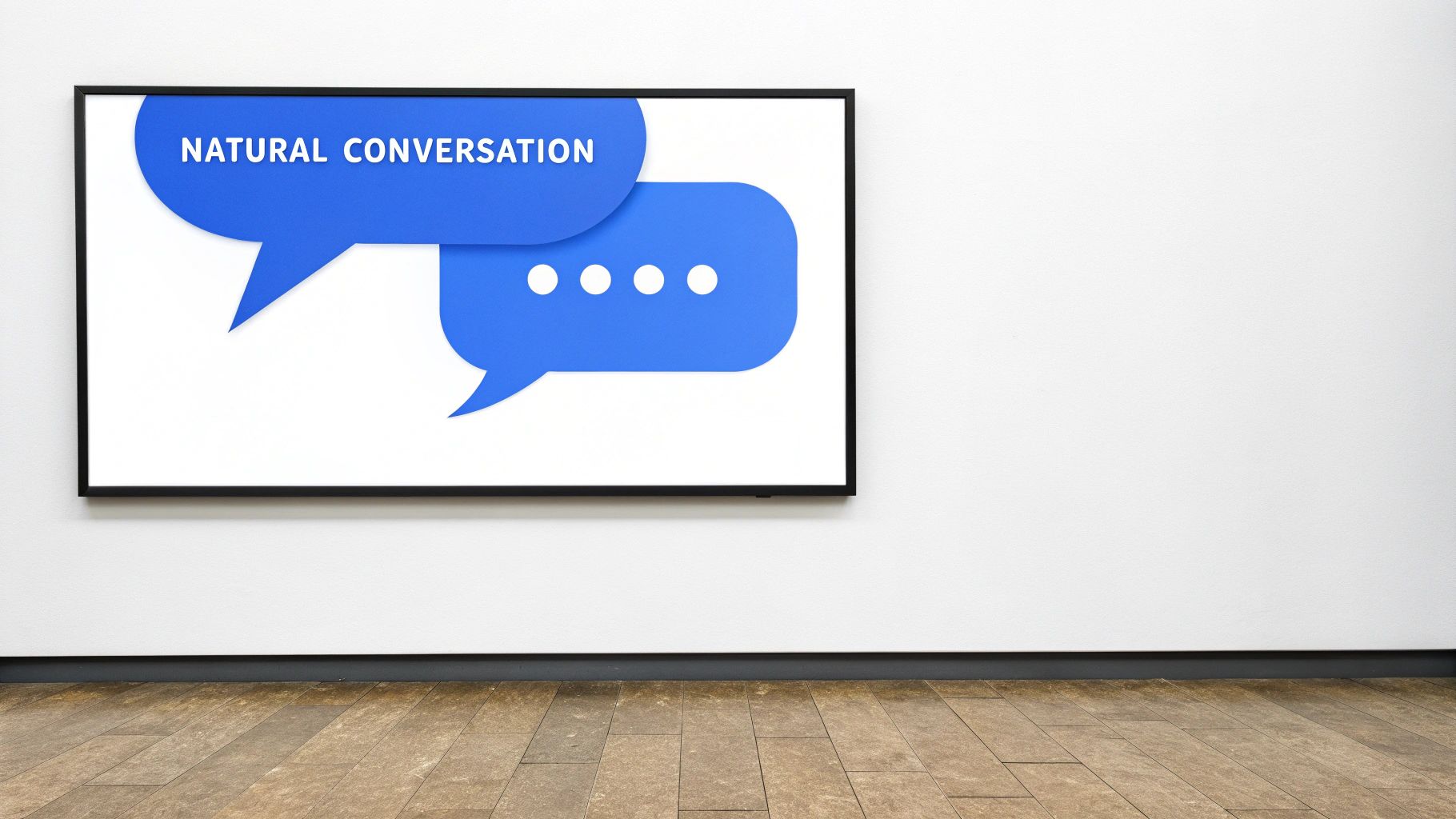
7 Essential Chatbot Best Practices for 2025
Discuss with AI
Get instant insights and ask questions about this topic with AI assistants.
💡 Pro tip: All options include context about this blog post. Feel free to modify the prompt to ask more specific questions!
In 2025, chatbots are more than just automated responders; they are the frontline of your digital customer experience. A poorly designed bot can frustrate users and tarnish your brand, while a great one can drive engagement, boost sales, and foster loyalty. The difference lies in a strategic approach grounded in proven techniques. For those specifically in retail, learning how to maximize these interactions is crucial; for a deeper dive, explore an ultimate guide to boosting sales with AI chatbots for e-commerce.
This guide moves beyond the basics to provide actionable, in-depth chatbot best practices that will transform your automated interactions from a necessary utility into a powerful asset. The goal is to create seamless, helpful, and human-like conversations that genuinely add value.
Whether you're building your first bot or optimizing an existing one, these seven principles will help you create experiences that users love, solve problems efficiently, and deliver measurable business results. We will break down how to define your bot's purpose, design natural dialogue, manage human handoffs, and ensure continuous improvement. Let's explore the strategies that separate the truly exceptional chatbots from the merely functional.
One of the most critical chatbot best practices is to establish a well-defined purpose and scope from the outset. A chatbot designed to do everything often accomplishes nothing well, leading to user frustration and project failure. By clearly identifying your bot's primary function and its operational boundaries, you create a focused and effective tool that genuinely solves a specific customer problem.

This approach involves pinpointing the highest-value interactions that can be automated. Instead of a generalist "assistant," consider a specialist. For example, a chatbot excelling at tracking orders will always outperform a generic bot that vaguely handles order tracking, product questions, and account support simultaneously. A narrow focus ensures higher accuracy, simpler conversational flows, and a more satisfying user experience.
A clear scope is the foundation for your entire chatbot strategy. It dictates the technology you'll need, the data required for training, the conversation design, and the metrics you'll use to measure success. Without this clarity, you risk building a solution that doesn't align with business goals or meet user expectations, wasting valuable time and resources.
Key Insight: A successful chatbot is not one that can answer every question. It's one that consistently and flawlessly resolves the specific task it was designed for.
To implement this practice effectively, follow these targeted steps:
- Identify One Core Use Case: Start by analyzing customer support tickets, live chat transcripts, and social media comments. Find the most frequent, repetitive, and simple-to-resolve query. This is your ideal starting point. Is it "Where is my order?", "What's your return policy?", or "What are your store hours?"
- Conduct User Research: Go beyond analytics. Survey or interview your target audience to understand their primary pain points and what they would find most helpful in an automated assistant. This ensures you're solving a real problem, not an assumed one.
- Document and Communicate Boundaries: Create a clear charter for your chatbot. Explicitly state what it can do and, just as importantly, what it cannot do. Make these capabilities clear to users in the bot's welcome message to set realistic expectations from the first interaction. For instance: "Hi! I can help you track your order or process a return. For other questions, I can connect you with a human agent."
Once your chatbot's purpose is defined, the next critical best practice is to design interactions that feel conversational and human-like. Users are more likely to engage with and trust a chatbot that communicates naturally rather than one that sounds robotic and rigid. This involves more than just understanding commands; it means creating a back-and-forth dialogue that mimics human conversation patterns, maintains context, and expresses a consistent personality.

A human-like chatbot doesn't try to deceive users into thinking it's a person. Instead, it leverages natural language and conversational fillers to make the interaction smoother and more pleasant. For instance, KLM's friendly "BlueBot" assists travelers with a helpful, reassuring tone that aligns with the airline's brand. This approach reduces friction and makes the automated experience feel more like a helpful conversation than a technical process.
A conversational design directly impacts user adoption and satisfaction. When a chatbot can handle nuances, remember previous parts of the conversation, and respond with an appropriate tone, it builds rapport and user confidence. This transforms the bot from a simple Q&A tool, like one you might use for an FAQ page, into a valuable brand ambassador. This is a key step in implementing advanced chatbot best practices. To learn more about how conversational design elevates basic functions, you can read about crafting a chatbot for FAQ on spurnow.com.
Key Insight: The goal isn't to trick users into thinking they're talking to a human, but to make the interaction so intuitive and natural that they don't care that it's a bot.
To implement this practice effectively, follow these targeted steps:
- Develop a Distinct Persona: Create a persona document that outlines your chatbot’s name, personality traits (e.g., friendly, professional, witty), tone of voice, and even its backstory. This guide ensures all its responses are consistent and aligned with your brand identity.
- Use Conversational Language: Program your chatbot to use conversational markers and empathy. Instead of a blunt "I am searching," try "Okay, let me just check on that for you." Small additions like "Hmm," "Got it," and "I see" make the flow feel much more organic.
- Incorporate Sentiment Analysis: Implement sentiment analysis to allow the bot to recognize user frustration, confusion, or satisfaction. It can then adjust its responses accordingly, offering an apology, providing clearer instructions, or escalating to a human agent when negative sentiment is detected.
- Test and Refine with Real Users: Regularly test your conversational flows with your target audience. Pay close attention to where they get stuck, what phrasing feels unnatural, and where the bot fails to understand context. Use this feedback to continuously refine its dialogue.
No chatbot can handle every query, and one of the most important chatbot best practices is planning for its limitations. A seamless handoff to a human agent is not a sign of failure but a feature of a well-designed, user-centric system. It ensures that when a conversation becomes too complex, emotional, or high-stakes, the user isn't left at a dead end, which prevents frustration and protects your brand's reputation.

This process involves more than just a button that says "talk to a human." A truly smooth transition means the chatbot recognizes the need for escalation, clearly communicates the next steps to the user, and transfers the full conversation context to the human agent. Platforms like Zendesk and Intercom excel at this, allowing bots to create support tickets or ping live agents with the entire chat history intact, so users never have to repeat themselves.
A clunky or nonexistent handoff process is a primary cause of customer churn. Forcing users to start over after they've already explained their issue to a bot creates immense frustration and makes your support system feel disjointed and inefficient. A seamless escalation path, however, builds trust and demonstrates that you value your customer's time, turning a potentially negative experience into a positive one.
Key Insight: The goal of a human handoff isn't just to solve a problem the bot can't. It's to make the user feel supported and understood throughout their entire journey, even when automation reaches its limit.
To build an effective handoff mechanism, focus on the transition experience:
- Define Clear Escalation Triggers: Determine precisely when a handoff should occur. Triggers could include a user asking to speak with an agent, repeated instances of the bot not understanding a query ("I'm sorry, I don't understand"), or the detection of negative sentiment like frustration or anger in user messages.
- Transfer Full Conversation Context: Ensure your chatbot platform is integrated with your CRM or helpdesk software. When an agent takes over, they must receive the entire transcript, including any information the user has already provided, like their name, order number, or a description of the problem.
- Set Clear Expectations: Be transparent with the user. If they are being transferred, inform them about the next steps and provide an estimated wait time. A message like, "I'm connecting you to a support agent who can help. The current wait time is about 2 minutes," is far better than silence.
- Train Agents on Bot Capabilities: Human agents should know exactly what the chatbot can and cannot do. This prevents them from redundantly asking for information the bot should have already collected and allows them to take over the conversation efficiently.
No chatbot is perfect; misunderstandings and technical glitches are inevitable. A crucial chatbot best practice is to design robust error handling and fallback mechanisms that guide users gracefully when things go wrong. Instead of a dead-end response like "I don't understand," a well-designed bot acknowledges the failure, sets expectations, and provides helpful next steps, preventing user frustration and conversation abandonment.

This process involves creating a tiered system of responses for when the bot fails to interpret a user's query. A great example is when a user asks a complex question, and the bot replies, "I'm not sure how to help with that, but I can assist with order tracking, returns, or product information. Which would you like?" This approach maintains control of the conversation and pivots the user back toward the bot's core functionalities.
Effective error handling is the safety net that preserves the user experience. A single frustrating interaction can cause a user to abandon the chatbot and form a negative impression of your brand. By planning for failure, you ensure that even unsuccessful interactions feel helpful and managed. This builds trust and demonstrates a commitment to customer support, even when automation reaches its limits.
Key Insight: A chatbot's value isn't just in its successful interactions, but in how gracefully and helpfully it manages its failures.
To implement this practice effectively, follow these targeted steps:
- Create Tiered Fallback Messages: Don't use a single "I don't understand" message. Develop a sequence. The first failure might offer a simple rephrase ("Sorry, I didn't get that. Could you ask in a different way?"). The second might list specific capabilities ("I can help with X, Y, or Z."). The third should offer a clear path to a human agent.
- Analyze Failure Points: Regularly review conversations where fallbacks were triggered. These "unhandled intents" are a goldmine of data, revealing gaps in your bot's training, confusing conversational flows, or new features you should consider adding. Use this analysis to continuously improve the bot's accuracy.
- Offer Human Escalation Clearly: When the bot fails multiple times, the best option is to connect the user with a person. Make this handoff seamless. For more complex situations, it's vital to have a well-defined customer service escalation process. You can learn more about building an effective customer service escalation process on spurnow.com to ensure smooth transitions from bot to human support.
In today's omnichannel world, customers expect a seamless experience whether they interact with your brand on your website, a mobile app, or a social messaging platform like Facebook Messenger. One of the most important chatbot best practices is to ensure this consistency extends to your automated assistant. The bot's personality, knowledge, and core capabilities should remain uniform, creating a reliable and predictable user experience across all touchpoints.
This means a user who starts a conversation on your website chatbot to check an order status should be able to get the same information, in the same tone, from the chatbot in your mobile app. Inconsistency erodes trust and causes confusion, forcing users to re-learn how to interact with your brand on each new channel. A unified approach strengthens brand identity and reinforces user confidence in your bot's reliability.
Failing to maintain consistency leads to a fragmented customer journey. A user might successfully resolve an issue on one platform but find the chatbot on another platform unhelpful or even unaware of previous interactions. This disconnect creates frustration and negates the efficiency gains of automation, often forcing users to seek out human agents, which is precisely what chatbots are designed to prevent.
Key Insight: A consistent multi-platform chatbot doesn't just look and sound the same everywhere. It accesses a single source of truth, ensuring the information it provides is accurate and uniform, regardless of the user's entry point.
To successfully implement a consistent multi-platform strategy, focus on a unified back-end architecture and design process:
- Design Platform-Agnostic Core Flows: Begin by mapping out your key conversational journeys, like checking order status or answering FAQs, without a specific platform in mind. This core logic can then be adapted with platform-specific UI elements (e.g., carousels on web, quick replies on Messenger) while the fundamental interaction remains the same.
- Centralize Your Knowledge Base: Use a single, shared knowledge base and NLU model for all chatbot instances. When you update a return policy or add a new product FAQ, the change should instantly propagate across your website, mobile app, and social media bots. This prevents contradictory answers and simplifies maintenance.
- Unify Analytics and Monitoring: Implement a centralized dashboard to track chatbot performance across all channels. This allows you to compare user behavior, identify channel-specific issues, and gain a holistic view of your chatbot's overall effectiveness, which is a crucial aspect of chatbot best practices.
Deploying a chatbot is not a one-time project; it’s the beginning of an ongoing optimization process. One of the most vital chatbot best practices is to implement a robust framework for continuous learning and improvement. A static bot quickly becomes outdated and ineffective, but one that evolves based on real user interactions will consistently grow more accurate, helpful, and valuable to your business.
This practice involves creating systems to collect, analyze, and act on performance data. By regularly reviewing how users interact with your chatbot, you can identify conversational dead-ends, uncover new intents you hadn’t planned for, and refine existing responses. Platforms like IBM Watson Assistant and Google's Dialogflow have built-in analytics and machine learning features designed to facilitate this exact feedback loop, helping the bot learn from its mistakes and successes.
A chatbot's initial performance is just a baseline. Without a continuous improvement strategy, its effectiveness will inevitably degrade as customer needs change, new products are launched, or policies are updated. Regularly updating your bot's knowledge base and conversational logic ensures it remains a reliable first point of contact for customers, reducing the burden on human agents and maintaining a high standard of user experience.
Key Insight: The most successful chatbots are treated like a product, not a project. They receive regular updates, iterative improvements, and strategic enhancements driven by user data and business goals.
To build a culture of continuous improvement around your chatbot, follow these steps:
- Establish a Feedback Loop: Integrate a simple rating system (e.g., thumbs up/down) after key bot responses. This provides direct, immediate feedback on the usefulness of its answers. Also, create a formal process for your human support agents to flag conversations where the bot failed, providing context on what went wrong.
- Regularly Review Conversation Logs: Schedule weekly or bi-weekly reviews of anonymized chat transcripts. Look for common phrases that the bot misunderstands (unhandled intents), identify frequently asked questions your bot can't yet answer, and pinpoint where users get frustrated or abandon the conversation.
- Update and Retrain Your Model: Use the insights gathered from logs and feedback to take action. Add new intents and training phrases to your NLU model, update incorrect or outdated answers, and refine confusing conversational flows. This iterative retraining is fundamental to improving chatbot accuracy over time.
In an age of increasing data sensitivity, one of the most non-negotiable chatbot best practices is to build a foundation of robust privacy and data security. Users are entrusting your bot with personal information, from names and email addresses to financial details and health concerns. Failing to protect this data not only violates user trust but can also lead to severe legal and financial repercussions.
Implementing privacy by design means integrating security measures into every stage of your chatbot's development, not just adding them as an afterthought. This includes using end-to-end encryption for conversations, ensuring compliance with regulations like GDPR and HIPAA, and being transparent about how data is collected, used, and stored. For example, a banking chatbot must be PCI DSS compliant, while a healthcare bot must adhere to strict HIPAA guidelines to protect patient information.
Trust is the currency of digital interaction. A single data breach can irreversibly damage your brand's reputation and customer loyalty. Proactively addressing privacy and security demonstrates a commitment to user safety, which can become a significant competitive advantage. It shows users that you value their privacy as much as their business, making them more comfortable engaging with your automated systems.
Key Insight: A secure chatbot isn't just about avoiding fines; it's about building a trustworthy relationship with your customers, which is essential for long-term engagement and brand loyalty.
To embed strong security and privacy into your chatbot strategy, follow these steps:
- Conduct a Privacy Impact Assessment (PIA): Before you build, analyze how your chatbot will handle personal data. Identify potential risks and map out how you will mitigate them. This includes deciding what data is truly necessary to collect and what can be avoided.
- Be Transparent with Data Usage Policies: Provide users with a clear, easy-to-understand privacy policy accessible directly within the chat interface. Crucially, this should include information on how users can opt out of AI training on their content, empowering them to control their data.
- Implement Strong Technical Safeguards: Use end-to-end encryption for all conversations, especially on platforms like WhatsApp. Anonymize or pseudonymize data wherever possible, and ensure your data storage solutions are secure and regularly audited for vulnerabilities. For more details on regulatory alignment, learn more about how the WhatsApp API can be GDPR compliant.
Aspect Define Clear Purpose and Scope Design Conversational and Human-like Interactions Implement Seamless Human Handoff Provide Clear Error Handling and Fallback Options Ensure Multi-Platform Consistency Implement Continuous Learning and Improvement Prioritize Privacy and Data Security Implementation Complexity 🔄 Medium: Requires upfront planning and clear definition High: Complex NLP and personality modeling High: Integration with human systems and escalation logic Medium-High: Extensive testing and fallback strategies High: Complex cross-platform synchronization High: Requires ongoing monitoring, analytics tools High: Compliance and encryption add complexity Resource Requirements ⚡ Moderate: Focused development and maintenance resources High: Computational power and specialized skills needed High: Human agent training and support system integration Moderate: Development effort for fallback and logging High: Development across multiple platforms High: Dedicated team and advanced analytics tools High: Security audits and compliance monitoring required Expected Outcomes 📊 ⭐⭐⭐⭐: Focused impact on user satisfaction and ROI ⭐⭐⭐⭐: Enhanced engagement and intuitive experience ⭐⭐⭐⭐: Maintains satisfaction during complex issues ⭐⭐⭐: Reduces user frustration and conversation dead-ends ⭐⭐⭐⭐: Uniform experience, reduces confusion ⭐⭐⭐⭐: Continuous improvement and data-driven insights ⭐⭐⭐⭐: Builds trust, ensures compliance, protects data Ideal Use Cases 💡 Specialized bots for clear single-use scenarios Customer-facing bots needing brand personality Support bots requiring smooth human escalation Bots prone to misunderstandings or ambiguous input Enterprises with multi-platform presence Bots needing long-term optimization and adaptability Bots handling sensitive or regulated user data Key Advantages ⭐ Easier maintenance, clear metrics, better resource use Higher user engagement, reduces friction, brand affinity Efficient human resource use, better problem resolution Maintains flow in errors, improves bot learning Consistent brand voice and user experience Proactive improvement, better ROI over time User trust, regulatory compliance, secure data handling
The journey from a basic chatbot concept to a sophisticated, value-driving digital assistant is paved with intentional design and strategic execution. Moving beyond the novelty of automation requires a commitment to the foundational chatbot best practices we’ve explored. This isn’t about simply deploying technology; it's about architecting an experience that feels helpful, intuitive, and genuinely supportive to your customers.
The principles discussed throughout this guide, from defining a laser-focused purpose to designing human-like dialogue and ensuring robust data security, are not just individual tips. They are interconnected pillars supporting a single, powerful goal: to build trust and deliver tangible value with every interaction. A great chatbot doesn't just answer questions; it anticipates needs, solves problems efficiently, and strengthens the customer's relationship with your brand.
Translating these concepts into a live, effective chatbot requires a clear path forward. Here are your actionable next steps to ensure your chatbot becomes a strategic asset, not just a technological feature:
- Conduct an Immediate Audit: Review your existing chatbot (or your plan for a new one) against the seven core practices discussed. Where are the gaps? Is your scope too broad? Is the human handoff clunky or nonexistent? Identifying weak points is the first step toward significant improvement.
- Prioritize the Human Element: Double down on conversational design. Your primary focus should be on creating interactions that feel natural and empathetic. This means investing time in writing scripts, defining your bot's personality, and designing clear, non-frustrating error-handling pathways.
- Establish a Feedback Loop: Continuous improvement is not optional. Implement a system for collecting user feedback right now. Use conversation logs, customer surveys, and handoff data to identify where the bot is succeeding and where it’s failing. This data is the fuel for all future optimization efforts.
Mastering these chatbot best practices unlocks benefits that extend far beyond simple ticket deflection. A truly effective chatbot frees your human support team from repetitive, low-level inquiries, allowing them to focus on complex, high-value customer issues that require a human touch. This not only boosts team morale but also elevates the quality of your overall customer service.
Ultimately, a well-executed chatbot strategy drives business growth. It enhances customer satisfaction, which in turn fosters loyalty and increases lifetime value. It provides a consistent, 24/7 brand presence, ensuring that no customer is left waiting. By embracing these principles, you are not just building a bot; you are investing in a scalable, efficient, and customer-centric future for your business.
Ready to implement these best practices without the technical overhead? Spur provides a powerful, no-code AI chat platform designed to centralize your communications and delight your customers. See how you can deploy a smarter, more effective chatbot today by visiting Spur.
